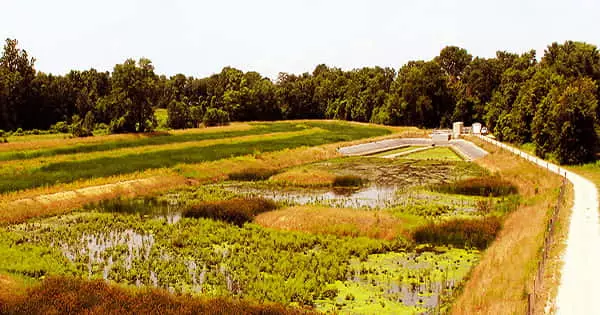The most cost-effective strategy to reduce nitrate and sediment loads in big streams and rivers, according to a new article by a lead author from the University of Kansas, is to build wetlands along waterways. Rather than focusing on individual farms, the study advises that wetlands conservation initiatives be done at the watershed level.
The paper, which was recently published in the Proceedings of the National Academy of Sciences, used computer modeling to investigate the Le Sueur River Basin in southern Minnesota, a watershed subject to runoff from intensive corn and soybean crop production that is typical of the Upper Midwest region.
“Excessive nitrate or sediment affect local fish populations, the amount of money we have to spend to treat drinking water, and there’s a downstream effect also,” said lead author Amy Hansen, assistant professor of civil, environmental & architectural engineering at KU.
However, in the United States, non-point source management is voluntary through incentive programs, and the scale at which these conservation techniques are generally addressed is the individual farmer, while a coordinated approach is significantly more successful.
Amy Hansen
“Our rivers integrate what’s happening across the landscape, so that location that you love to go and fish or swim whether that continues to be a great place to fish or swim has a lot to do with the choices that people are making further upstream. Excess pollution creates algal blooms or hypoxic or ‘dead zones’ in a water body downstream, such as a reservoir or the ocean. The nitrate from the Mississippi River Basin is directly linked to the dead zone in the northern Gulf of Mexico.”

The researchers evaluated several watershed measures to enhancing water quality, such as reducing agricultural runoff and adding wetlands and then calculated the financial implications of each. The researchers discovered that most techniques are ineffective because they rely on individual farmers’ voluntary involvement and are administered by a patchwork of different entities.
“Currently, there are individual management or conservation practices, and those include cover crop, high-precision fertilizer application, reduced tillage, constructed wetlands, and ravine tip management. Those are some of the different practices we considered,” Hansen said.
“However, in the United States, non-point source management is voluntary through incentive programs, and the scale at which these conservation techniques are generally addressed is the individual farmer, while a coordinated approach is significantly more successful. In a way, it’s like a recycling program where you’re saying, ‘Anyone recycling one thing is better than no one recycling.’ True, any recycling is preferable to none, but a coordinated effort will save money and improve efficiency.”
Constructed wetlands are the most beneficial of these techniques, according to Hansen and her co-authors, especially when the size and placement are considered at the scale of a watershed, or a whole region that drains into a shared canal. Wetlands, according to the KU researcher, do two things well: they slow down water as it flows toward streams and rivers, and they contain plants and bacteria that can absorb fertilizer nutrients.
“Microbes and plants within wetlands are actually removing the nitrate from the water,” Hansen said. “With sediment, on the other hand, what the fluvial wetlands are doing is holding water back during these high flows and by holding that water back you’re getting lower peak stream flows, which is reducing the amount of near channel sediment that’s being transported downstream.”
While Hansen’s study focuses on water quality, her co-authors from the University of Minnesota, the University of California-Irvine, and other schools around the country offered a variety of views to the problem of enhancing agricultural water quality. A grant from the National Science Foundation aided the partnership.
“This work would not have been possible without the diverse expertise and perspective of the team composed of hydrologists, ecologists, geomorphologists, bio-geochemists, social scientists, and environmental economists,” said Efi Foufoula, the lead principal investigator on the project from the University of California-Irvine.
“We were able to take a fresh look at the problem because to the NSF’s ongoing assistance, which allowed us to collect significant field data, develop new models, and interact with stakeholders. We hope that our results will affect policy and management as the clock ticks to meet the water quality targets of the state.”
Indeed, the economics of establishing tiny, shallow fluvial wetlands and stabilizing ravines is a major emphasis of the current study. These techniques “were clearly more cost-effective than field management,” according to the investigators. However, the researchers discovered that excellent wetland performance necessitated ideal location and that even cost-effective wetlands might be prohibitively expensive for a single farm or agency to implement.
A complete approach, according to the PNAS research, must target an entire watershed as a system, pooling monies from several programs and organizations and selecting places for fluvial wetlands that would result in the largest decrease in nitrates and sediments reaching streams.
“This work shows that we can’t make real progress toward our goals for improving water quality in agricultural areas with more of a business-as-usual approach,” said study co-author Jacques Finlay, a professor in the College of Biological Sciences at the University of Minnesota.
” Instead, conservation activities, as well as the investments that support them, can be more effective if they take into account the interactions that underpin the source of water pollution, as well as how alternative management approaches affect them.”
The Le Sueur River Basin was utilized as a proof-of-concept watershed, but the researchers claim their findings may be extended to agricultural districts across the Midwest.
















